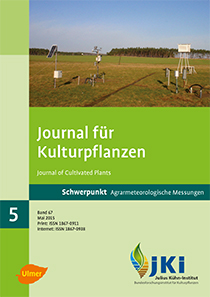Trail field Dahnsdorf – 15 years of agrometeorological measurements Part 4: Extreme weather events
Keywords:
Air temperature, extreme weather events, normal value, precipitation, trial field, yieldAbstract
15 years of meteorological observations at the trial field in Dahnsdorf were used to analyze extreme weather events and their effect on the yields of various crops (winter wheat, winter rye, winter barley, winter oilseed rape, potatoes). The definition of extreme weather events was based on common meteorology threshold values (number of days) and time sequences in which – constantly over several days – the considered area was prevailed by unusual weather conditions. Two hot spells (from 15th July to 14th August 2003 and from 15th July to 01st August 2006), two cold spells (from 01st to 31st January 2010 and from 28th January to 14th February 2012), periods of prolonged drought (from 04th April to 06th May 2007 and from 05th 25th October 2007) and days with downpour were analyzed.
The heat spells lasted 31 and 18 days, respectively. The average air temperature was 22.7°C and 23.4°C, respectively; the maximum daily average was 27.9°C and 27.0°C, respectively, the daily maxima were at 34.7°C and 36.6°C, respectively, which were up to 10.0 K above the long-term average. 15 out of 31 and 12 out of 18 days, respectively, were hot days (maxima ≥ 30.0°C).
In the cold periods, the daily minimum air temperatures decreased to –18.7°C and –23.6°C, respectively, the daily average to –13.1°C and –19.5°C, respectively. The periods lasted 31 and 18 days, respectively; the recorded average temperatures were –5.2°C and –10.0°C, respectively. The most extreme deviation from the long-term average was –18.2 K. 29 out of 31 and 18 out of 18 days were ice days (maxima < 0.0°C).
The considered period from 1998 to 2012 saw three periods with more than 20 days without any rain and another four periods with very low precipitation at the trial field in Dahnsdorf. The longest rainless period lasted 33 days (from 04th April to 06th May 2007).
Downpours with daily totals ≥ 50.0 mm were recorded on four days. In the normal value period (1961/90), the reference point at Treuenbrietzen saw only one day in these 30 years.
Effects of extreme weather events were analyzed according to defined features resulting from counts (e.g. number of hot days) or time series (e.g. consecutive days ≤ 0.2 mm precipitation, cold periods). They were summarized in four feature groups (icy winters, hot summers, low precipitation during the (main) growing season, heavy precipitation during harvest). The analysis compared the yields of individual crops in the year with the extreme weather event with the respect mean yield of the remaining years.
In 2003, extreme weather events of the “Hot Summer” group led to a substantial loss of yields in all crops (winter wheat: 41%; winter rye: 27%; winter barley: 40%; winter oilseed rape: 45%; potatoes: 58%). Significantly lower losses occurred – in similar weather conditions, but with higher precipitation in the (main) growing season – in 2006.
Yield losses were also found for the “consecutive days with ≤ 0.2 mm precipitation” group in 2007 (33 consecutive rainless days).
The “Icy Winter” group seems to have no or only a slight effect, if it occurs alone. Although both years (2010 and 2012) had a snow cover at the icy winter, the yield was highly variable: While in 2010 after an icy winter some yield losses were still recorded, the yields of the year 2012 with similar weather conditions exceeded the average of the remaining years. Therefore, subsequent weather events in the rest of the year seem to have taken effect on the yield.
DOI: 10.5073/JfK.2015.05.04, https://doi.org/10.5073/JfK.2015.05.04
Downloads
Published
Issue
Section
License
The content of the journal is licensed under the Creative Commons Attribution 4.0 License. Any user is free to share and adapt (remix, transform, build upon) the content as long as the original publication is attributed (authors, title, year, journal, issue, pages).
The copyright of the published work remains with the authors. The authors grant the Journal of Cultivated Plants, the Julius Kühn-Institut and the OpenAgrar repository the non-exclusive right to distribute and exploit the work.







